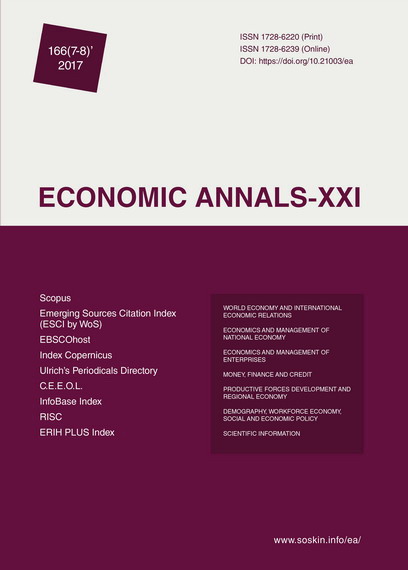Reduction of social and economic asymmetry of territories in new economic conditions
Reduction of social and economic asymmetry of territories in new economic conditions
Author(s): Sergey Zheleznyakov, Igor RisinSubject(s): Economy
Published by: Institute of Society Transformation
Keywords: Territory; Level of Life; Quality of Life; Asymmetry; Strategy; Process; Development; Russia;
Summary/Abstract: The article presents the research results of the economic and social situation in Russian territories in 2013-2015 obtained by calculation of indicators characterising the level and quality of life in the territories under analysis. The assessment of the quality of life in territorial entities of the Russian Federation, including the Central Federal District (CFD) of the Russian Federation (except Moscow and Moscow Region), was carried out using the following group of indicators: quality of the population; level of the income of the population; working conditions; population provided with comfortable housing; healthcare services; safety of the population; quality of environmental management system. The authors assess strong and weak points of the reduction of social and economic asymmetry within territorial entities of the Russian Federation by 2016, which have to be considered when developing a qualitatively updated strategy of regional development for the 2020-2025 period. After carrying out the analysis for the CFD, the following findings have been obtained: The average income growth is observed in all the cities, except for Volgograd, Kostroma, Kurgan, Samara and Saratov. The population with the income below the subsistence level increased in all the analysed regions. The greatest natural population decline was observed in Vladimir, Smolensk, Tambov, Tver and Tula regions, whereas Belgorod, Yaroslavl, Voronezh, Lipetsk and Kostroma regions displayed a positive dynamic. The slow growth of housing indicator is observed in all the cities. The change in the number of doctors in the considered regions from 2013 to 2015 shows a beneficial situation in Oryol, Belgorod, Bryansk, Kostroma, Tambov and Tula regions where an increase in the number of doctors of all specialties per 10,000 inhabitants is observed. In other regions, we have noted a drop in the number of doctors. We noted an increase in the indicator «Number of the Registered Crimes per 100,000 inhabitants» in all the regions from 2014 to 2015, which is a negative trend.
Journal: Економічний часопис - ХХІ
- Issue Year: 166/2017
- Issue No: 7-8
- Page Range: 80-85
- Page Count: 6
- Language: English

